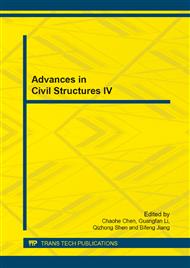p.71
p.75
p.83
p.89
p.97
p.106
p.113
p.121
p.127
Optimization of Steel Lattice Trusses Considering Members Stability
Abstract:
This paper extends the optimization model of space truss finite element method to planar steel lattice truss structures under multiple constraints involved with the strength and the stability of members as well as the mid span deflection based on sequential linear programming (SLP) and affine-scale dual algorithm with the size of members as the optimization variables and the minimum weight as the optimization objective. Algorithm implemented with programming, an example of square pyramid space grid is meant for the verification of the optimization performance that the algorithm and program extends an active control to the stability and the mid span deflection as well simultaneously during optimization. Moreover, stress and deflection constraints were enlarged and reduced, the optimization results indicate that more districted constraints bring about greater ultimate steel consumption, which extends a certification to the effectiveness of the proposal optimization model to deal with all kinds of stress and displacement constraints.
Info:
Periodical:
Pages:
97-105
Citation:
Online since:
July 2014
Authors:
Price:
Сopyright:
© 2014 Trans Tech Publications Ltd. All Rights Reserved
Share:
Citation:


